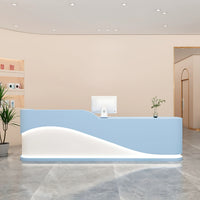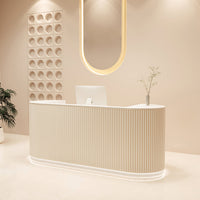How to Refinish an Executive Desk?
kaguyasuContent Menu
● Materials and Tools Needed
● Step 1: Preparing Your Workspace and Desk
>> Protect Your Environment
>> Remove Hardware and Clean the Desk
● Step 2: Removing the Old Finish
>> Chemical Stripping vs. Sanding
>> Tips for Effective Stripping
● Step 3: Repairing and Preparing the Wood
>> Filling Damage
>> Fixing Loose Joints
>> Optional: Bleaching or Staining the Wood
● Step 4: Sanding the Desk
● Step 5: Sealing and Finishing
>> Choosing a Finish
>> Applying the Finish
>> Optional: Painting or Decorative Touches
● Step 6: Reassemble and Final Touches
● Frequently Asked Questions
● Citations:
Refinishing an executive desk can breathe new life into a cherished piece of furniture, restoring its elegance and functionality. Whether your desk is worn, scratched, or simply outdated, refinishing it yourself can be a rewarding project that enhances your workspace. This comprehensive guide will walk you through the process step-by-step, covering materials, preparation, refinishing techniques, and finishing touches.

Materials and Tools Needed
Before starting, gather the necessary materials and tools to ensure a smooth refinishing process:
- Drop cloths or plastic sheeting to protect your workspace
- Chemical stripper (e.g., Citristrip) or sandpaper (150, 220, and 300 grit)
- Plastic putty knife or scrapers
- Soapy water and soft cleaning brush
- Furniture refinisher or mineral spirits
- Medium steel wool
- Stainable wood filler (optional)
- Wood stain (optional)
- Polyurethane or polycrylic sealer
- Rags, foam brushes, and sponge brushes
- Palm sander and/or orbital sander
- Protective gloves, eye protection, and mask for chemical use
Step 1: Preparing Your Workspace and Desk
Protect Your Environment
Lay down drop cloths or plastic sheeting to protect floors and surrounding furniture from dust, paint, and chemicals. Work in a well-ventilated area or outdoors if possible to avoid inhaling fumes from chemical strippers or finishes.
Remove Hardware and Clean the Desk
Remove all hardware such as drawer pulls, knobs, and hinges. Clean the desk thoroughly with soapy water and a soft brush to remove dirt, oils, and grime. Allow it to dry completely before proceeding.
Step 2: Removing the Old Finish
Chemical Stripping vs. Sanding
There are two main ways to remove the existing finish:
- Chemical stripping is ideal for desks with intricate carvings or curved details, as it preserves the wood's character. Apply a chemical stripper like Citristrip according to the product instructions, let it sit, then scrape off the softened finish with a plastic putty knife. Clean the residue with soapy water and dry promptly.
- Sanding works well for flat surfaces. Start with coarse grit (150) to remove the bulk of the finish, then progress to finer grits (220 and 300) for smoothing. Use a palm or orbital sander for efficiency, but be cautious not to sand through veneer layers.
Some refinishing projects combine both methods: sanding flat areas and chemically stripping detailed parts.
Tips for Effective Stripping
- Always wear gloves, eye protection, and a mask when handling chemicals.
- Work in small sections to avoid the stripper drying out before scraping.
- Use medium steel wool dipped in furniture refinisher or mineral spirits to remove stubborn finish remnants.
Step 3: Repairing and Preparing the Wood
Filling Damage
Inspect the desk for dents, scratches, or holes. Use a stainable wood filler to fill imperfections, ensuring it matches the wood grain. After drying, sand the filled areas smooth with fine-grit sandpaper.
Fixing Loose Joints
If any joints or parts are loose, apply wood glue and clamp them until dry to restore structural integrity.
Optional: Bleaching or Staining the Wood
If you want to change the wood tone or lighten dark woods, consider bleaching the desk with household bleach or a commercial wood bleach. This process may require multiple applications and thorough drying between coats.
Alternatively, apply a wood stain to achieve your desired color. Use a brush or rag to apply, wipe off excess stain, and allow it to dry fully. Multiple coats can deepen the color.
Step 4: Sanding the Desk
After repairs and any staining, sand the entire desk lightly with fine-grit sandpaper (220 or 300 grit) to smooth the surface and prepare it for sealing. Hand sand tight corners with a mouse sander or sanding block.
Remove all dust with a tack cloth or damp rag before sealing.
Step 5: Sealing and Finishing
Choosing a Finish
For an executive desk, durability and appearance are key. Polyurethane (oil-based or water-based) or polycrylic sealers provide excellent protection against scratches, spills, and wear.
Applying the Finish
- Use a foam or sponge brush to apply a thin, even coat of sealer.
- Allow it to dry fully according to the manufacturer's instructions.
- Lightly sand with very fine sandpaper (320 grit or higher) between coats to ensure smoothness.
- Apply 2-3 coats for optimal protection, sanding between each.
Optional: Painting or Decorative Touches
If you prefer a painted finish, prime the desk first and use high-quality furniture paint. You can also refresh hardware or add decorative accents like gold leaf on feet or drawer pulls.
Step 6: Reassemble and Final Touches
Once the finish is completely dry, reattach hardware and clean the desk surface. Consider adding felt pads under the legs to protect your floor.
Frequently Asked Questions
Q1: Can I refinish an executive desk with veneer?
A: Yes, but be careful not to sand through the thin veneer layer. Chemical stripping is often safer for veneer surfaces.
Q2: How long does the refinishing process take?
A: Depending on drying times and complexity, refinishing can take several days to a week.
Q3: What if my desk has water stains or ink marks?
A: Light sanding or chemical stripping usually removes surface stains. For deep stains, wood bleach may be necessary.
Q4: Can I use a spray finish instead of brushing?
A: Yes, spray finishes provide a smooth coat but require proper ventilation and spraying equipment.
Q5: How do I maintain my refinished desk?
A: Clean with a soft cloth and mild cleaner. Avoid harsh chemicals and use coasters to prevent damage.

---
Citations:
[1] https://www.youtube.com/watch?v=3G7jknr-vJw
[2] https://www.youtube.com/watch?v=Voz8lXiJxEk
[3] https://www.maisondepax.com/how-to-refinish-a-wood-desk/
[4] https://www.virginiasweetpea.com/vintage-office-desk-makeover/
[5] https://www.reddit.com/r/finishing/comments/1ec6yc8/refinishing_an_old_teacherexecutive_desk/
[6] https://wellshetried.com/bleached-desk-refinish/
[7] https://blog.csdn.net/qq_41552508/article/details/129793125
[8] https://lakesiderestoration.blog/2020/01/04/executive-desk-makeover/
[9] https://juejin.cn/post/7389200711404716082
---
Hot Tags: China, Global, OEM, private label, manufacturers, factory, suppliers, manufacturing company
















